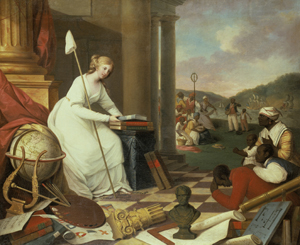Art & Artifacts
Discover the Library Company's Art and Artifact Collection
Distinguished Painters
Samuel Jennings
Samuel Jennings (active 1789-1834) was a native Philadelphian who spent most of his life painting in England. Scant details of his early life are known; it is believed that he was born c. 1755. He attended the College of Philadelphia from 1770 to 1773. Jennings taught drawing and painted portraits and miniatures. In 1787, he traveled to London, carrying a letter of introduction from Benjamin Franklin, to study with Benjamin West. In London, his paintings were exhibited repeatedly at the Royal Academy and the British Institution. Most of these works were allegorical or history paintings.
Samuel Jennings (active 1789-1834).
Liberty Displaying the Arts and Sciences, or The Genius of America Encouraging the Emancipation of the Blacks, 1792.
Oil on canvas.
60 1/4" x 74".
Library Company of Philadelphia. Gift of the artist, 1792.
Liberty Displaying the Arts and Sciences is a landmark piece as the first painting done by an American-born artist to address the issue of slavery. While in London, Jennings learned of the construction of the new building for the Library Company of Philadelphia. He decided to celebrate this occasion by painting an allegorical picture. He wrote to his father, “I should esteem myself very happy to have the honor of presenting a Painting to the Company that would be applicable to so noble, and useful an Institution.”[1] He proposed to the Library Company’s directors a classical allegorical painting of Clio, Calliope, or Minerva. The directors, many of whom where Quakers and active in the Abolition Society, wrote that they preferred “Liberty (with her Cap and proper Insignia) displaying the arts by some of the most striking Symbols of Painting, Architecture, Mechanics, Astronomy, &ca. whilst She appears in the attitude of placing on the top of a Pedestal, a pile of Books, lettered with, Agriculture, Commerce, Philosophy & Catalogue of Philadelphia Library.”[2] The committee also stipulated the broken chains underneath the feet of Liberty. The painting is often cited for its abolitionist sentiments as well as for its significance in African American history. It remains celebrated and highly regarded for its unprecedented subject matter, as well as its significance in the Library’s history.
[1] Minutes of the Library Company. Vol. 3, April 1, 1790.
[2] Minutes of the Library Company. Vol. 3, May 6, 1790.
